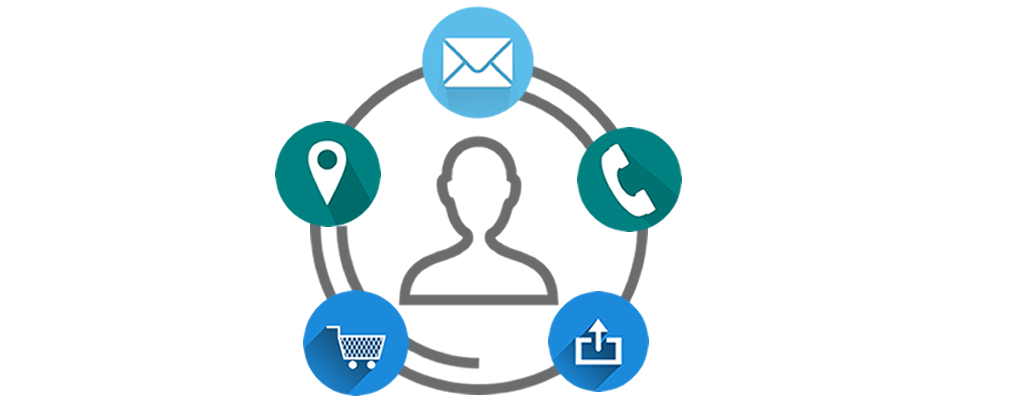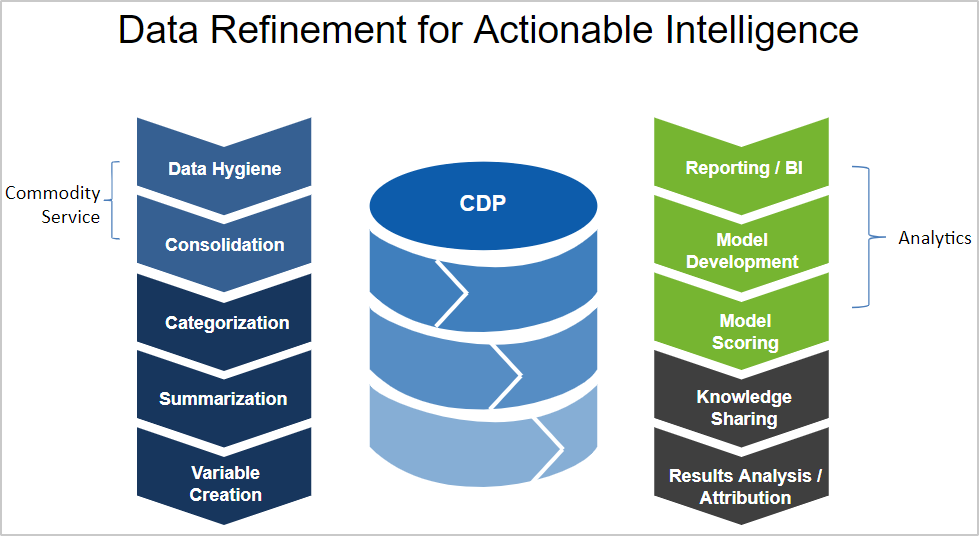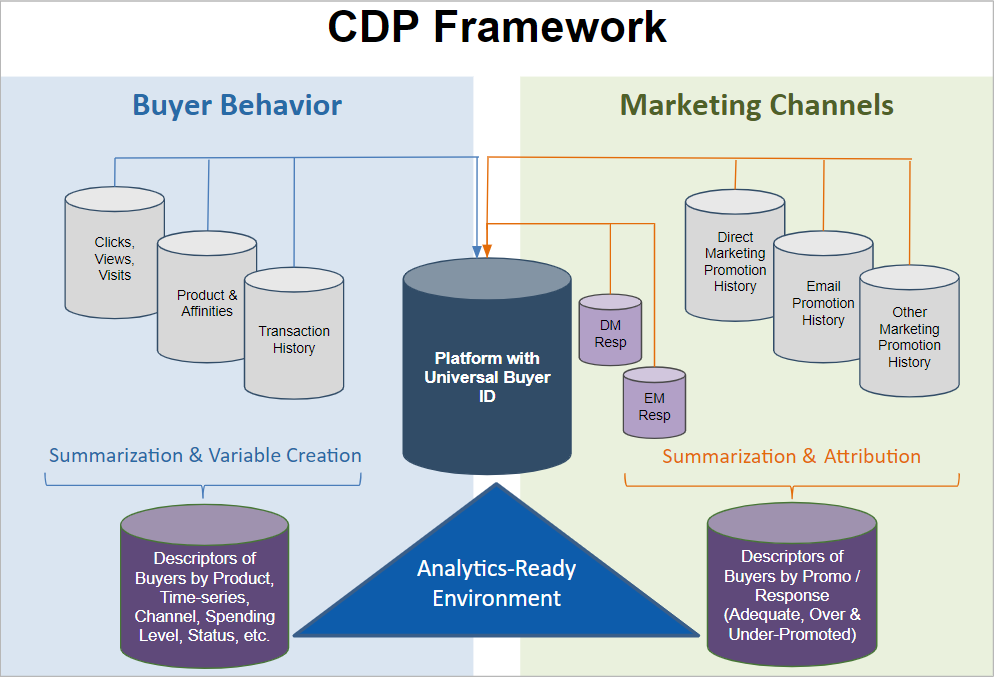Customer Data Platform (CDP): The Marketer’s Guide
If you’ve heard the term “CDP” but don’t know just what it is – you are not alone.
The term “CDP” has generated considerable coverage in modern marketing over the past couple of years, but it has gained further prominence in 2018 and 2019. Essentially, a Customer Data Platform software is a web-based interface that consists of three core components – a database, the ability to connect to multiple channels, and a marketer-friendly interface – that help drive marketing and sales initiatives.

What You Will Learn Here
There are other platforms that contain some of these capabilities, but not all. These include CRM (Customer Relationship Management), DMP (Data Management Platform), and Data Lakes/Warehouses – which we will break down a bit later on.
With so much disparate information out there, we sought to do more than simply define a CDP and its capabilities. Plenty of other marketing companies and media outlets have already attempted to do that (with varying degrees of success).
That is why nailing the true definition can be so confusing. However, with over 20 years of innovation in marketing, analytics, and technology under our belt (plus access to a vast network of experts) we not only know what a CDP really is, we’ve figured out what sets the best platforms apart from the rest.
[bg-related-posts]
What a CDP is [and What it Does]
Make no mistake.
There is no shortage of customer data. The true problem is that much of it is disorganized and incomplete. In turn, businesses struggle with ways to efficiently sort through it all and consolidate it into something actionable, targeted, and personalized.
Customers tend to be fickle, spontaneous, and impatient. Today, customers simply do not interact with brands in a linear fashion. Instead, they come into contact with numerous ones across a variety of channels (web, social, email, mobile, tablets, and other addressable media) at any given time – generating tons of data points along the way.
Gartner defines a CDP as a marketer-friendly, web-based interface that integrates three core capabilities:
- Data Collection – Autonomously collect/sort an unlimited amount of first-party, personalized data from various sources.
- Profile Unification – Synthesize profiles at the individual level and conjoin customer characteristics to specific identities.

CDP vs Other Platforms
People often ask about the differences between a CDP and other marketing platforms. The most prominent queries are how a CDP compares to a CRM (Customer Relationship Management), a DMP (Data Management Platform), and Data Warehouses and Lakes. This can create some confusion, especially since they all seem relatively similar on the surface.
CDP vs CRM (Customer Relationship Management)
While a CRM works to connect with consumers and utilize data to form customer profiles (like a CDP) – they simply are not designed to filter enormous quantities of data from so many sources. They also limit the amount of detail of ingested data, lack advanced identity matching capabilities, and restrict outside access to their internal databases.
CDP vs DMP (Data Management Platform)
For DMPs, these pre-built audiences are used to enhance targeted display ads. On the other hand, a CDP uses predictive analytics to discern patterns, simplify data, and put it to use.
DMP data is also cookie-based, which means that a typical DMP profile only lasts for about 90 days before terminating. A CDP employs persistent, finely detailed, real-time customer profiles that last indefinitely.
CDP vs Data Lake/Warehouse
Also, since data warehouses are designed and run by IT teams, marketers have to frequently depend on the IT Department, which slows down the whole process. While technical participation and know-how is still necessary with a CDP, it is much more accessible overall. Therefore, marketers can directly access and run a CDP much more smoothly and efficiently.

Classifying Your Customers
Many companies are dealing with customer data issues. In 2017, ClickZ referenced a recent Campaign
survey of over 100 global CMOs and marketing executives. When asked what they felt were the biggest challenges currently facing marketers, they found some pertinent results:
- 57% felt hindered in their ability to carry out broad digital information.
- 22% felt their data and analytics capabilities were lacking.
- 13% were unable to improve targeting and personalization.
- 10% endeavored to build better marketing automation.
- 9% wished to better understand their customers’ journey.
In
Gartner’s 2017-2018 CMO Survey, marketing leaders said they invested two-thirds of their budget in supporting customer retention and growth through digital marketing.
One of the reasons why this is so important is because there are different types of customers (i.e. gender, income, interests) who are always at different stages of purchasing and skipping across multiple platforms.
The One-Time Buyer
With the incredibly high bar set by mega-retailers like Amazon, Walmart, and Target, many retailers are struggling and in dire need of an innovative, effective way to form
personalized and lasting relationships with their customers. Additionally, subscription-based platforms – from Netflix to Dollar Shave Club – have experienced a meteoric rise by essentially guaranteeing year-round customer retention.
This leads to a critical conundrum: Can traditional retail/e-commerce companies find ways to not just attract new buyers (which is already incredibly costly), but retain them in a manner similar to modern subscription businesses?
With so many purchasing options out there that can be accomplished with a simple swipe of a finger or the click of a button, consumers are – by and large – extremely fickle.
The truth is, most retail buyers
do not come back after their first purchase – about 75 percent to be exact. This means that most of a retailer’s customer base contributes
little to negative profit. This is not a recipe for sustained success – especially since it costs so much to attract most of these one-time buyers in the first place
.
The MVB (Most Valuable Buyer)
On the other end of the spectrum is the
MVB. These customers, while only making up about
15-20% of a company’s total customer base, typically account for more than three-quarters of all revenue
.
These are the loyal consumers who are willing to spend more money, more often than the rest. Obtaining a one-time buyer is basically equivalent to gaining a subscriber, except they are not spending a fixed amount over a structured period of time – like $9.99 per month. In fact, there is nothing holding them back from spending as much as they want, as many times as they choose.
In a
2018 Forbes Insights/Treasure Data Survey,
44% of organizations reported that a CDP was helping to drive their customer loyalty and ROI.
Here are some other highlights of the survey:
- 93% anticipated that employment and analysis of customer data in decisions and campaigns would create a noticeable shift in their ability to meet disruptive and competitive challenges.
- 53% said that the transparency provided through CDP platforms enabled their teams to react more quickly to changes in markets or customer preferences.
Inactive/Fading Customers
Market research studies indicate that acquiring a new customer is anywhere from
5 to 25 times more expensive than retaining an existing customer. Moreover, it is at least
5 times easier to keep a current customer than it is to acquire a new one.
This means that the act of “rescuing” fading customers through marketing intervention is extremely critical – particularly because increasing customer retention rates by just
5 percent increases profits from 25 to 95 percent.
The truth is, most customers have a start and end date to their relationship with any brand. You can identify if a customer is starting to lapse by monitoring their placement in the BLC and checking if they are no longer purchasing at the rate they did before. If that is the case, your objective to get them back on track.
Key Takeaways
The goal of any marketing platform is to help retailers identify which subjects are either a current or potential MVB. From there, they should monitor purchases and channel activity, gauge/influence brand loyalty, and deliver targeted, timely updates on the latest releases and promotions in order to actively increase the likeliness of another transaction.
For instance, if either consumer regularly demonstrates an affinity for one particular style or category of a product, they can actively respond by offering corresponding
product suggestions for the next purchase.
The best platforms help to paint accurate, intricate portraits of your buyers. By knowing exactly who you are selling to, you are ahead of the game. From there, the odds of securing and retaining MVBs skyrocket.
Beyond CDP: Predictive Marketing Automation (PMA)
The goal of a CDP is to organize and unify customer databases. It extends beyond customer interactions and gathers further information about calls, emails, purchases, etc.
However, after that point, the work stops.
This is for two main reasons:
- A CDP doesn’t actually deliver messages on its own.
- A CDP’s main function is solely to ingest data. It is not directly actionable and requires “piggybacking” onto other software platforms in order to do so.
With a
Predictive Marketing Automation platform (PMA), every possible function is tied together in one singular package. A CDP is just one component of a PMA, so there is no need to “piggyback” onto anything else. This simplifies the process while generating more powerful results.
CDPs and other platforms lack the predictive intelligence that a PMA possesses and deploys. At best, they consist of old-fashioned triggers with simple, rules-based logic that cannot produce inherently actionable insights.
Meanwhile, a PMA covers the entire process all the way through to profit – delivering real, tangible revenues.
Is a PMA Right for You?
Clearly, properly grasping and implementing customer data is considered a key problem in the field. However, a PMA is the most practical under a particular set of circumstances.
One factor to take into consideration is cost. PMAs employ a vast set of sophisticated, cutting-edge technologies. This requires investing a substantial amount of time and money. Generally, most PMAs fall in the realm of six figures per year.
In addition, your company should be large enough and possesses the standard customer-facing systems and staff to properly utilize/analyze the technology. While it is a powerful tool, a PMA’s true effectiveness depends upon how it is designed, implemented, and managed.
However, if employed the right way, the benefits can easily outweigh the costs. A PMA lessens the amount of time and money necessary for gathering, filtering, and activating data while actually increasing its utility. In fact – with the best software – the resulting spikes in sales can pay for the product multiple times over.
Conclusion
A CDP’s function is to collect, cleanse, and organize consumer data. In fact, it can process any kind or class of data currently available without limit.
However, it is not directly actionable on its own, and needs to merge with other platforms (like a PMA) in order to actually deliver messages.
Businesses do not just want to collect, assemble, and assess data. They want to apply it into something useful and generate concrete results
. They want to grow their customer base, develop real, personalized, lasting relationships with their buyers (MVBs), and maximize revenue
.
With a clear, coherent customer data strategy, the right implementation tools, and a proper cross-functional team in place, a PMA can hasten, strengthen, and broaden your organization’s marketing framework.
While
BuyerGenomics’ PMA contains a built-in CDP, it was designed not just to ingest experience and transaction data, but to use them autonomously to drive sales, grow customer loyalty, and prevent churn.








